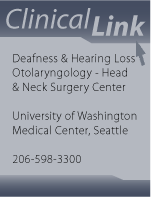A Possibility for Restoring Hearing Loss
Discovery shifted attention to hair cell regeneration
When it comes to some kinds of hearing loss, there's no shortage of potentially helpful devices ranging from hearing aids to cochlear implants.
However, one area of hearing research is directed at curing age-related hearing loss and other kinds of deafness. That research engine was kick-started about 15 years ago by Dr. Edwin Rubel, professor of otolaryngology-head and neck surgery and of physiology and biophysics at the UW's Virginia Merrill Bloedel Hearing Research Center.

In the hope of helping people who have nerve deafness, Dr. Edwin Rubel studies chicks' ability to re-grow their hearing nerve cells.
Rubel studies the regenerative properties of hair cells, which aren't hairs at all. They're actually small cells with protein-filled protrusions. These cells line one part of the cochlea, a snail-shaped structure in the inner ear. The protrusions, which bunch together like microscopic tufts of grass, are mechanical receptors that vibrate when struck by sound waves. The hair cells turn those vibrations into electrical nerve impulses, which travel through ganglion cell bodies and into the cochlear nerve, where those impulses are sent into the brain and processed as sound.
Many kinds of hearing loss, including those that are age-related, congenital, or environmental (such as repeated exposure to a loud noise or ear trauma), are actually due to loss of hair cells, and that loss was believed to be permanent.
More than a decade ago, Rubel's team made a remarkable discovery: hair cells actually regenerated on their own in the ears of birds.
"That was a great surprise to us, obviously," Rubel said. "We thought that once the hair cells were damaged, they lost them for life, and that they'd have hearing loss that would last for life."
The discovery, which was made simultaneously with another group outside the UW, helped make hair cell regeneration a sudden gathering point for hearing loss research.
Although a few devices exist to bring sound to those with hearing loss, hair cell studies are attempting to cure deafness. Treatments such as cochlear implants, which artificially translate sounds into electrical impulses and send them to the brain, try to bypass the lost hair cells.
"That's been a wonderful treatment for people with profound hearing loss," Rubel said. "But if you really want to cure hearing loss, hair cell research is the only game in town."
After years of extensive research on hair cells in a variety of organisms, scientists have determined that hair cells naturally regenerate in nearly all vertebrate animals, except mammals, such as humans. Rubel and others are trying to transfer their knowledge of hair cells and the means through which the cells regenerate, in an attempt to bring about a similar process in humans.
"We're trying to better understand how the bird does it, and we'd like to know how we can use information from birds to trick mammals into doing the same thing," Rubel explained.
Beyond seeking findings that can be applied to ameliorating hearing loss, though, Rubel is interested in the biology of the central nervous system. He examines development of the brain, pathways of the auditory system, and how experience influences both behavior and the development of the brain's hearing centers.
One of Rubel's experiments looked at hearing loss in a Bengalese finch, which learns only one song in its lifetime. When it lost its hearing, the bird's song deteriorated, as expected. But when the bird regained its hearing, the song returned. Not a tune similar to the earlier version, he said, but exactly as before, which meant there was a template for the song in the bird's brain.
That sort of esoteric research appeals to Rubel, who has been studying the nervous system for four decades. Clinical applications of scientific research are also important to the longtime faculty member.
"If my lab could help create a cure for hearing loss, that would be great," said Rubel, who came to the UW in 1986.
This is the right place for such developments, Rubel said, because of the collaborations possible within the Bloedel Center and throughout the UW.
"The progress we made in this area wouldn't have been possible without the collegial atmosphere that characterizes the UW," Rubel said. "You can literally find wonderful collaborators right across the street. We can routinely find colleagues with experience and expertise we don't have who are almost always eager to collaborate, and that's immensely valuable."
Development note The Oberkotter Foundation gave the Virginia Merrill Bloedel Hearing Research Center $1.5 million to study hair-cell regeneration. Then the foundation promised an additional $1.25 million if the Center could raise $1.25 from its contributors. UW Medicine is seeking gifts from those who, like the Oberkotter Foundation, would like to support the quest to cure profound hearing loss. |
